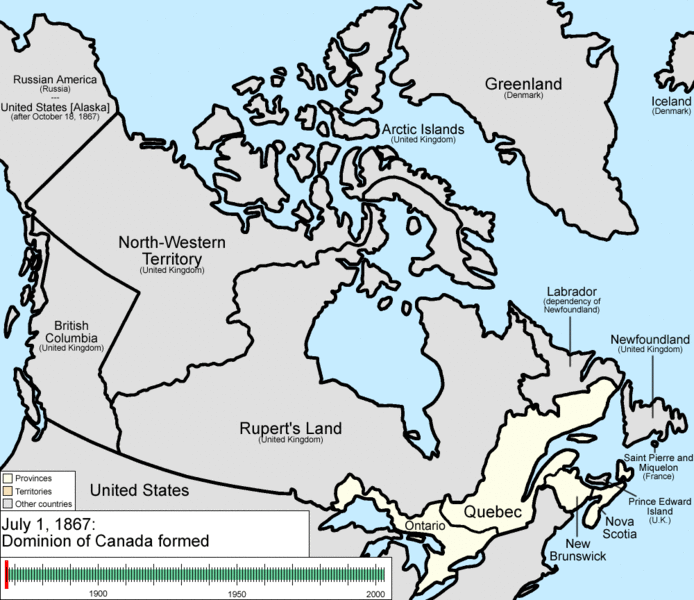Chapter 1. Confederation and the Peoples of Canada
1.1 Introduction

Canada in 1867 covered an area roughly equivalent to the original Thirteen Colonies of Britain—the core elements of the United States of America (U.S.) in 1783. However, Ontario (formerly Canada West), Quebec (formerly Canada East), New Brunswick, and Nova Scotia were much more sparsely populated, and the new Dominion was a curious mix of highly concentrated and urban populations on the one hand, and overwhelmingly rural and remote on the other. For example, much of southern Ontario was farmland, and the northern coastline of Lake Superior was forestry and mining territory in which only small clusters of Aboriginal and non-Aboriginal people lived. There was some degree of industrialization underway from which a Canadian working class emerged. Cities like Hamilton, Ontario transformed from leafy commercial towns in the 1850s to smoky industrial engines in the late 1860s. The former colonies — now “provinces” — were not uniformly happy to be part of the new federation. Britain’s role in the post-1867 era was still unclear. Indeed, the meaning of the new federal union of colonies (and, to be clear, although they were provinces they were all still colonies as well) was not entirely obvious to the British North Americans themselves.
Historians have debated for many years just what was accomplished in the British North America Act (BNA Act) of 1867. There is the matter of what the so-called “Fathers of Confederation” believed they were doing and agreeing to. And there was also the question of Britain’s objectives: The new constitution might have signalled greater decision-making autonomy when it came to internal matters, but there was no suggestion of colonial independence. What, too, did the rest of the British North Americans — the people of the Plains and British Columbia, for example — believe was underway? Was the BNA Act a pivotal moment for them? And what of the Aboriginal peoples whose ancestral and current territories were now captured within the boundaries of the new “Dominion”? This chapter summarizes the steps that led to the new constitution, and identifies the many peoples who both comprised the emergent country and who were soon (or not so soon) going to be entangled in Canadian expansionism. It may be convenient to think of 1 July 1867 as a new beginning but it was, in a great many respects, more about continuity than change.
Learning Objectives
- Describe the political and economic background to Confederation.
- Identify the principal features of the Aboriginal and non-Aboriginal people in the northern half of North America.
- Explain the residual uncertainty about, and the hostility toward, the Canadian project.
Long Descriptions
Figure 1.1 long description: A series of historical maps of Canada between 1867 and 2003. In order, the maps are labelled:
- July 1, 1867: Dominion of Canada formed.
- July 15, 1870: Rupert’s Land and North-Western Territory join, become Northwest Territories; Manitoba formed.
- July 20, 1871: British Columbia joins.
- July 1, 1873: Prince Edward Island joins.
- July 26, 1874: Ontario provisionally expanded north and west.
- April 12, 1876: District of Keewatin formed.
- September 1, 1880: British Arctic Islands join as part of North-West Territories.
- July 1, 1881: Manitoba expanded.
- May 7, 1886: Border of District of Keewatin adjusted.
- August 12, 1889: Ontario’s expansion finalized.
- October 2, 1895: District of Keewatin enlarged.
- June 13, 1898: Yukon Territory formed, Quebec enlarged.
- May 23, 1901: Yukon Territory adjusted.
- September 1, 1905: Alberta and Saskatchewan formed, District of Keewatin dissolved.
- May 15, 1912: Manitoba, Ontario, and Quebec enlarged; North-West Territories renamed Northwest Territories.
- March 11, 1927: Border with Newfoundland adjusted.
- March 31, 1949: Newfoundland joins.
- April 1, 1999: Nunavut formed.
- December 6, 2001: Newfoundland renamed Newfoundland and Labrador.
- April 1, 2003: Yukon Territory renamed Yukon.
Media Attributions
- The Evolution of the Canadian Provinces © Golbez is licensed under a CC BY-SA (Attribution ShareAlike) license
The Atlantic Coast colonies established in the 17th and 18th centuries; rebelled against British rule in 1775–83 and became the core elements of the United States.
An assemblage of states or provinces with roughly comparable rights in which all the constituent parts relinquish some of their authority to a separate, central government.

